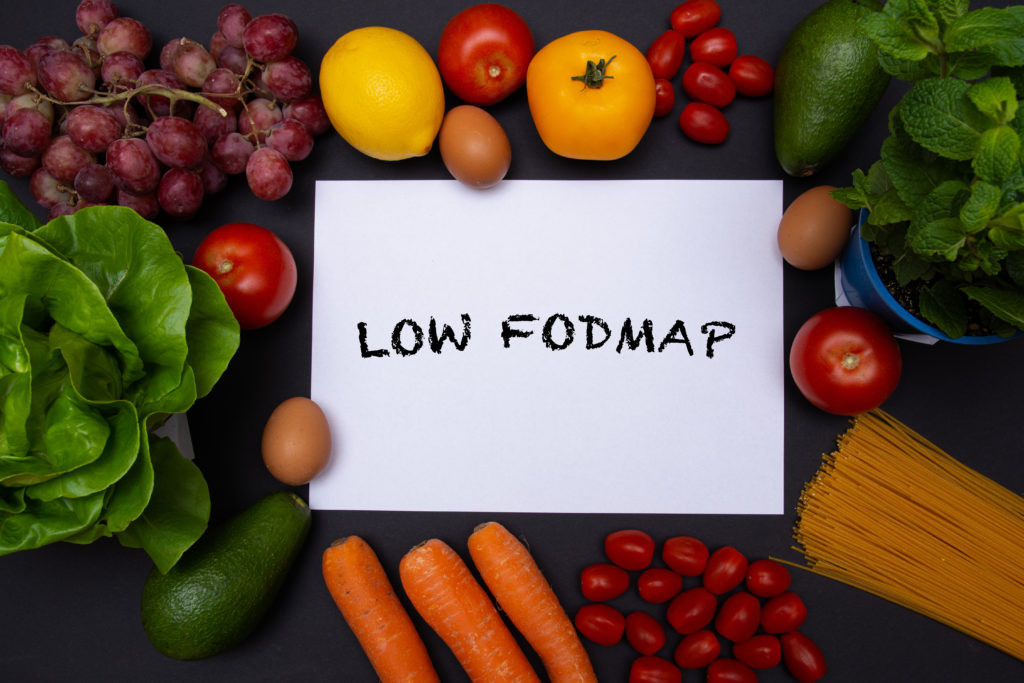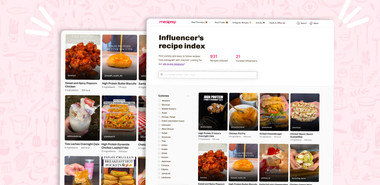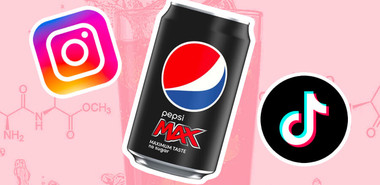What is the Low FODMAP diet?
The low FODMAP diet was designed to address Irritable Bowel Syndrome (IBS). It is often used to minimise symptoms in Small Intestinal Bacterial Overgrowth (SIBO) but is used in conjunction with antibiotics as antibiotics is the first line of treatment for SIBO.
It is a 3 phase diet that aims to identify foods that trigger negative gastrointestinal symptoms and identify an individual’s current threshold/tolerance for different dietary triggers.
- Phase 1: Low FODMAP diet (2-6 weeks)
- Phase 2: FODMAP introduction (6-8 weeks)
- Phase 3: FODMAP personalisation
FODMAPs are fermentable short-chain carbohydrates that are slowly absorbed or indigestible including lactose, fructose, sorbitol, fructans and GOS. These short-chain carbohydrates are:
- Fermentable
- Oligosaccharides
- Disaccharides
- Monosaccharides
- And
- Polysaccharides
The subgroups of FODMAPS are:
- Fructans: mainly found in onion, garlic, wheat and rye
- Galacto-oligosaccharides: mainly found in pulses, legumes and beans
- Lactose: mainly found in cows milk, yoghurt and cheese. Lactose is higher in soft cheese (brie, camembert, feta) than hard, aged cheeses (cheddar, swiss, parmesan).
- Sugar Polyols (sorbitol and mannitol): mainly found in some fruits and vegetables. Also used as an artificial sweetner in diet products e.g. sugar-free lollies, sugar-free gum and diet soft drinks.
- Excess fructose: found in high fructose corn syrups (rarely in Australian products but often in international products e.g. peanut butter and biscuits), honey, apples.
How does the Low FODMAP diet work?
In IBS, a more sensitive gut in addition to changes in gut motility (the speed in which food and water move through the gut) can cause pain.
Since small-chain carbohydrates are not readily absorbed in the small intestine, they pull in water via a process called osmosis. They then over into the large intestine where the bacteria ferments them, creating hydrogen, carbon and methane gases. [1]
In individuals without IBS, this can cause us to get gassy and a little uncomfortable, as if we had just eaten a little too many baked beans. If you don’t have IBS, your threshold for FODMAPs are generally much higher and there is no additional benefit to limiting FODMAPs.
In individuals with IBS, this leads to pain, bloating, and altered motility (which can cause diarrhea or constipation. Limiting fermentable short-chain carbohydrates reduces how much the intestinal walls stretch, reducing these symptoms
Important to remember:
The two most important things about low fodmap to remember is that it is intended to be temporary and guided by a dietitian.
The reason for this is that a low FODMAP diet is extremely restrictive and can lead to inadequate fibre intake and micronutrient deficiencies if foods aren’t introduced for an extended period.
If you are considering undertaking the low FODMAP diet, ensure that you receive guidance by a Monash University Low FODMAP trained dietitian for best results.
What can I eat on the Low FODMAP diet?
You might be surprised to know that there is still many fruit, vegetables, protein sources, dairy products and even grains that are low-fodmap and should be included during phase 1. When you work with a dietitian, they will ensure that your diet is nutritionally adequate, safe and personalised to you lifestyle, budget and preferences on the low FODMAP diet and after.
Foods that are allowed on a low FODMAP diet (in appropriate portions and frequency) are
- Fruits:
- grapes, pineapples, strawberries, papaya, mandarins, passionfruit, orange, cantaloupe
- ½ cup cranberry or orange juice
- Vegetables:
- Potato, carrots, green beans, pumpkin, zucchini, Lettuce, cucumber, green capsicum
- Protein sources:
- Plain, cooked meat, chicken, eggs, seafood and fish
- Legumes and beans:
- Canned chickpeas, canned lentils, boiled lima beans
- The canning process reduces the FODMAP load of chickpeas and lentils, however, their dried forms are still considered a high FOMAP food.
- Nuts and seeds: pine nuts, peanuts, macadamias,
- Lactose-free milk, soy milk (made from soy protein only – not whole soybeans), cheddar cheese
- Dark chocolate, regular sugar, maple syrup, rice malt syrup

What can I not eat on a Low FODMAP diet?
There are quite a few high FODMAP foods that are excluded on the first phase in the low FODMAP diet such as:
- Onion
- Garlic
- Some nuts and seeds e.g. pistachios, cashews
- All dried fruit and some fresh fruits: apple, pears, mangoes, figs, watermelon, lychee, plums, dates (This also excludes any cereals or baked goods that contain dried fruit).
- Some vegetables: mushrooms, cauliflower, sweet potato, snow peas, celery, asparagus, snap peas, artichoke, leek
- Gluten containing foods e.g. breakfast cereals made from wheat, rye, regular pasta, cous cous, gnocchi, semolina
- Most legumes and beans e.g. soybeans (and soy milk made from whole soy beans), black beans, kidney beans, falafels, baked beans
- Marinated meats and processed meats (ham, salami, sausages)
- Milk, yoghurt, cheese, condensed milk, custard, coconut milk
- Sugar-free lollies, honey, and agave syrup
Pros
- Evidence-based treatment for IBS and currently the gold standard diet for alleviating IBS symptoms. 70% of individuals with IBS experience improved symptoms on the low FODMAP diet. [2]
- Relieves and manages IBS on a diet that is personalised and less restrictive then cutting out entire food groups.
- While the low FODMAP diet is useful temporarily to relieve symptoms, it is not a long-term solution. However, a personalised low FODMAP diet that is achieved through undertaking the 3 phases with a dietitian is effective long-term in managing IBS symptoms and improving quality of life.
- May be effective in reducing inflammation in Crohn’s disease and Ulcerative Colitis. [3]
Cons
- Phase 1 is highly restrictive and staying on a strict, low FODMAP diet is not intended as a long-term solution.
- Completing the entire FODMAP protocol as outlined by Monash University researchers is a lengthy and time-consuming process. There are other options to simplify and speed up the FODMAP approach, but it means that individuals may not be aware of all their dietary triggers. You can discuss your unique situation with a dietitian to find the best approach for you.
- Often unsuccessful when attempted alone. The researchers founding the Low FODMAP diet have strongly recommended that the diet be undertaken with a dietitian that specialises in IBS.
- Limit variety of healthy gut bacteria. A diet with a wide variety of fruit, vegetables and wholegrains is important in maintaining a healthy gut microbiome. Restricting fermentable short-chain carbohydrates can have temporary negative impacts on the gut microbiome. That’s why it is extremely important to continue to Phase 2 and Phase 3 and not stay on a low FODMAP diet forever.

Who is this diet suitable for?
This diet is suitable for individuals with irritable bowel syndrome or experiencing bloating, gut discomfort, pain, excessive wind or changes in bowel habits (e.g. constipation, diarrhea or both).
Who is this diet not suitable for?
The low FODMAP diet is not suitable for individuals who are severely underweight, nutritionally compromised or children.[4] This diet is not intended to be a weight loss diet but is highly restrictive and can result in weight loss.
How do I get started?
- Contact your doctor and an IBS FODMAP – certified dietitian. Your doctor can confirm a diagnosis of IBS and identify and red flags that may indicate another medication conditions such as colon cancer, coeliac disease and inflammatory bowel disease. A dietitian can help guide you through the low FODMAP diet process, ensure you are correctly reintroducing foods, minimise symptoms during the reintroduction phase and tailor a diet that takes into account your threshold, food intolerances, preferences and goals.
- Find low FODMAP alternatives for your favourite foods and staple meals. Can’t live without garlic? You can use a garlic infused oil to replace garlic.
- Replace high FODMAP vegetables with low FODMAP alternatives such as potatoes, tomatoes, cucumbers and broccoli
- Find in-season low FODMAP fruits. Winter is right around the corner which means an abundance of low FODMAP kiwis, bananas, mandarins, oranges and pineapple.
- Tackle the takeaway. Find a trusted low FODMAP meal provider while on the FODMAP challenge such as Dineamic that have a wide range of low FODMAP dishes including Moroccan Beef and Sweet Potato, Lamb Tagine and Wild Rice, and Chicken and Vegetable Risotto.



